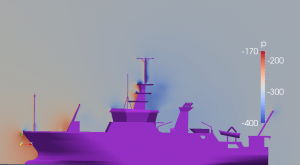The Celtic Explorer
Background
My project is going to be a part of an already started project. The Celtic Explorer is an Irish research vessel that is used frequently in many research expeditions and carries a large array of scientific instruments. The simulation is part of a project run by a research group in NUI Galway. This project tries to accurately measure the motion of the mast placed on the vessel in an effort to predict changes in readings taken by an instrument at the top of the mast and adjust data accordingly.
My Challenge
Due to the very high resolution of the Celtic Explorer OpenFOAM model, the output files are very large.
Such datasets cannot be easily visualized on desktop workstations and in numerous cases, cannot be visualized on the machines they were produced on. This is a memory issue.The previous solution was, taking advantage of OpenFoam’s run-time post-processing capabilities, that the simulation saves a 2D slice of the pressure and velocity fields at every time-step. This allows Paraview to open and visualize the output as an animation.

Current 2d method for viewing the output
My goal is visualize the whole model using the client/server mode of Paraview. This will allow us to run an MPI parallel Paraview Server process on a large machine (a cluster) and do computationally and memory expensive data processing and rendering tasks. Connection to the server uses the familiar GUI application. Thanks to this mode, it will be possible to visualize large data sets such as the Celtic Explorer Model output.
Once I get it, I would like to create a high-resolution 3D animation to show you the benefits of HPC.
First Steps with Paraview and OpenFoam

Fancy Motorbike
I started to “play” with Paraview using an example that you can find in the OpenFoam folder: Motorbike simulation. This OpenFoam example produces the flow and pressure of the wind in a MotorBike, and you can get image as cool as this one. You can see the streamlines calculated with the velocity vector field and coloured by the pressure (scalar variable).
HPC Everywhere
You need HPC (High Performance Computing) at least to simulate the OpenFoam Model (that is simulate the turbulence effects in the vessel) and to view the results. I want to note how useful is HPC, this is not a weird, abstract, theoretic problem. The vessel is real, the mast is real, and the effects of a solution to this problem will have side-effects for a lot of research projects. So I’m so happy to do my bit to help in understanding better the problem.

Happy!
